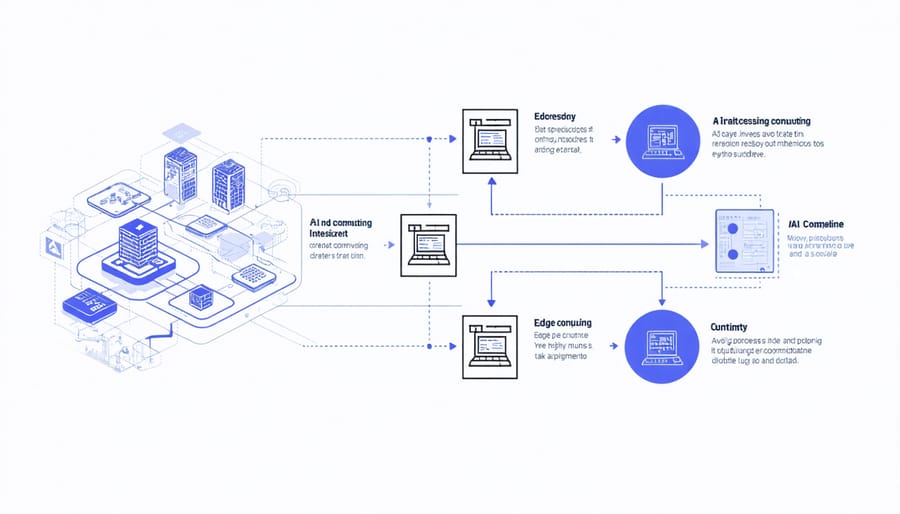Edge computing infrastructure revolutionizes construction site operations by processing mission-critical data within milliseconds, directly where it’s generated. This fundamental shift from cloud-dependent systems to localized computing networks enables real-time monitoring of equipment performance, worker safety protocols, and structural integrity measurements – crucial capabilities for modern construction projects operating in remote or bandwidth-constrained environments.
As construction sites evolve into increasingly connected ecosystems, edge computing infrastructure serves as the backbone for instant decision-making and automated responses. By deploying processing power closer to data sources – from IoT sensors on heavy machinery to structural monitoring devices – construction teams can reduce latency, enhance security, and maintain operational continuity even when internet connectivity falters.
The strategic implementation of edge computing infrastructure addresses three critical challenges in contemporary construction: the need for instantaneous data processing in safety-critical applications, the requirement for reliable operations in areas with limited connectivity, and the demand for cost-effective data management solutions that don’t strain network resources. For construction professionals seeking to modernize their operations, understanding and implementing edge computing infrastructure has become not just an technological advantage, but an operational necessity.
The Core Components of Edge Computing Infrastructure

Edge Nodes and Processing Units
Edge computing infrastructure relies on a hierarchical network of processing units strategically positioned at various locations across construction sites. At the most basic level, IoT sensors and actuators collect real-time data about environmental conditions, equipment performance, and structural integrity. These devices typically feature minimal processing capabilities but are essential for data acquisition.
Gateway devices serve as intermediate processing units, aggregating data from multiple sensors and performing initial filtering and analysis. In construction environments, these ruggedized gateways are designed to withstand harsh conditions while providing reliable connectivity and basic edge processing capabilities. Modern gateways often incorporate AI acceleration modules for real-time analysis of sensor data, enabling immediate response to critical situations.
Local edge servers represent the most powerful processing units in the edge infrastructure hierarchy. These servers handle complex computations, run sophisticated analytics algorithms, and manage data storage requirements. For construction applications, edge servers are typically housed in weather-protected enclosures and feature redundant power supplies to ensure continuous operation.
Processing units at each level are equipped with varying computational capabilities:
– Sensors: Low-power microcontrollers for basic data collection
– Gateways: Multi-core processors with specialized AI acceleration
– Edge Servers: High-performance computing systems with GPU support
This distributed processing approach enables real-time decision-making while optimizing bandwidth usage and reducing latency in construction site operations.
Network Architecture and Connectivity
Edge computing infrastructure requires a robust and reliable network architecture to ensure seamless communication between edge devices, local processing units, and central data centers. In construction environments, this typically involves a multi-layered approach combining both wireless and wired connectivity solutions.
The primary communication protocols commonly deployed include 5G for high-bandwidth applications, Wi-Fi 6 for local area coverage, and Low-Power Wide-Area Networks (LPWAN) for IoT sensor networks. These protocols work in concert to support various edge computing requirements, from real-time video analytics to environmental monitoring systems.
Network redundancy is crucial in construction settings, where environmental conditions can be challenging. Multiple connection paths and failover systems ensure continuous operation even if primary networks experience disruption. This often includes implementing software-defined networking (SDN) solutions that can automatically route traffic through the most efficient paths.
Latency management is another critical consideration, with most construction applications requiring response times under 10 milliseconds. This necessitates careful placement of edge nodes and optimization of network routes. Quality of Service (QoS) policies help prioritize critical data streams, ensuring that essential applications like safety monitoring systems receive adequate bandwidth.
Security measures must be integrated at every network layer, including encrypted communications, secure access controls, and network segmentation. This creates a defense-in-depth approach that protects sensitive construction data while maintaining system performance and reliability.
Real-Time Monitoring Applications in Construction

Structural Health Monitoring
Structural health monitoring has emerged as a critical application of edge computing in modern construction, enabling real-time assessment of building and infrastructure integrity. A notable implementation can be found in the Shanghai Tower, where over 400 edge sensors continuously monitor structural stability, vibration patterns, and load distribution across its 128 floors.
The integration of edge computing with digital twin monitoring systems allows for instantaneous data processing and analysis at the source, reducing latency and enabling immediate response to potential structural issues. This approach has demonstrated a 60% improvement in response time compared to traditional cloud-based monitoring systems.
Edge nodes positioned throughout the structure process data from multiple sensor types, including strain gauges, accelerometers, and temperature sensors. These nodes perform preliminary analysis locally, transmitting only relevant data to central systems, which significantly reduces bandwidth requirements and operating costs. During a recent structural assessment, this system detected minor foundation settling issues within milliseconds, allowing engineers to implement corrective measures before any significant problems developed.
The implementation requires careful consideration of sensor placement, edge node distribution, and power management. Construction teams typically deploy redundant systems to ensure continuous monitoring, with each edge node capable of operating independently if network connectivity is compromised. This distributed architecture has proven particularly valuable during extreme weather events, where traditional monitoring systems might fail due to network outages.
Success metrics from various implementations show a 40% reduction in maintenance costs and a 30% improvement in predictive maintenance accuracy when compared to conventional monitoring methods.
Equipment Performance Tracking
Edge computing infrastructure has revolutionized equipment performance tracking in construction sites by enabling real-time monitoring and analysis of vital machinery data. Construction companies are leveraging edge computing solutions to collect and process data from sensors installed on heavy equipment, creating a sophisticated monitoring ecosystem that enhances operational efficiency and reduces downtime.
These systems typically utilize a network of IoT sensors that capture critical parameters such as engine temperature, fuel consumption, hydraulic pressure, and operational hours. The edge computing nodes process this data on-site, allowing for immediate response to potential issues before they escalate into major problems. This immediate processing capability is particularly valuable in remote construction sites where connectivity to central servers may be limited or unreliable.
Implementation success stories demonstrate significant improvements in equipment maintenance schedules and operational costs. For example, a major construction firm reported a 35% reduction in unexpected equipment failures after deploying edge-based monitoring systems across their fleet. The system’s predictive maintenance capabilities helped identify potential failures before they occurred, leading to more efficient scheduling of repairs and reduced project delays.
Real-time performance tracking through edge computing also enables better resource allocation and utilization. Project managers can access detailed equipment usage patterns, helping optimize deployment and scheduling of machinery across different project sites. The system’s ability to process and analyze data locally means decisions can be made faster, without waiting for cloud-based systems to respond.
Construction companies implementing these solutions should focus on selecting robust edge devices capable of withstanding harsh site conditions while ensuring seamless integration with existing fleet management systems. Regular calibration of sensors and maintenance of edge computing infrastructure is essential for maintaining system reliability and data accuracy.
Implementation Strategies and Best Practices
Security Considerations
Implementing a secure edge infrastructure requires a multi-layered approach to protect sensitive construction data and operational systems. Physical security measures must include restricted access zones, surveillance systems, and environmental monitoring for edge computing installations at construction sites.
Data encryption remains fundamental, with AES-256 encryption standards implemented for both data at rest and in transit. Authentication protocols should utilize multi-factor authentication (MFA) and role-based access control (RBAC) to ensure only authorized personnel can access critical systems and data.
Network segmentation is essential, creating isolated environments for different operational components while maintaining secure communication channels between edge devices and central systems. Regular security audits and penetration testing help identify vulnerabilities before they can be exploited.
As construction technology evolves, emerging security challenges require adaptive security measures. Organizations must implement automated threat detection systems and establish incident response protocols specific to edge computing environments.
Security policies should address firmware updates, patch management, and end-of-life procedures for edge devices. Regular staff training on security protocols and best practices ensures human factors don’t compromise the system’s integrity. Compliance with industry standards and regulations, such as ISO 27001 and GDPR, must be maintained throughout the edge computing infrastructure’s lifecycle.
Scalability Planning
Effective scalability planning is crucial for edge computing infrastructure in construction environments. The key lies in developing a flexible architecture that can accommodate growing data volumes and increasing device connections without compromising performance or reliability.
Start by conducting a thorough assessment of current and projected workloads, including the number of IoT sensors, monitoring devices, and data processing requirements. Plan for a 3-5 year growth trajectory, factoring in potential expansion of construction sites and integration of new technologies.
Implement a modular design approach that allows for easy addition or removal of edge nodes. This flexibility enables seamless scaling of computing resources as project demands evolve. Consider using containerization and microservices architecture to ensure efficient resource allocation and simplified management of distributed systems.
Network capacity planning is equally important. Design your edge infrastructure with redundant communication pathways and sufficient bandwidth to handle peak loads. Include buffer capacity of 30-40% above projected requirements to accommodate unexpected surges in data traffic.
For optimal scalability, adopt a hierarchical edge computing model with three tiers: edge devices, local aggregation points, and regional processing centers. This structure enables efficient data handling while maintaining low latency for critical applications.
Consider implementing auto-scaling capabilities that can dynamically adjust resources based on real-time demands. This approach optimizes resource utilization and helps maintain cost-effectiveness as your infrastructure grows.
Future-Proofing Edge Infrastructure
Integration with AI and Machine Learning
Edge computing infrastructure is increasingly becoming intertwined with artificial intelligence and machine learning capabilities, revolutionizing how construction sites process and analyze data. By implementing AI algorithms directly at the edge, construction companies can achieve near-instantaneous decision-making capabilities without the latency associated with cloud processing.
Modern construction sites are leveraging edge AI for various critical applications, including real-time structural analysis, equipment performance monitoring, and AI-powered threat detection. These systems can process vast amounts of sensor data locally, enabling immediate responses to changing site conditions and potential safety hazards.
The integration of AI at the edge particularly excels in applications requiring rapid response times, such as automated equipment coordination and worker safety monitoring. Edge-based neural networks can analyze video feeds in real-time to detect safety violations, while machine learning algorithms can predict equipment maintenance needs before failures occur.
Construction firms implementing edge AI solutions are reporting significant improvements in operational efficiency, with some projects achieving up to 30% reduction in downtime and 25% improvement in resource utilization. These systems are particularly valuable in remote construction sites where internet connectivity may be limited, as they can continue functioning independently of cloud services.
To maximize the benefits of AI integration, construction companies should focus on deploying purpose-built edge computing hardware that can handle the computational demands of modern AI algorithms while maintaining resilience in harsh construction environments.

Sustainability and Energy Efficiency
Edge computing infrastructure presents unique opportunities for implementing sustainable practices while maintaining high performance. Energy efficiency in edge facilities starts with optimizing power usage effectiveness (PUE) through advanced cooling systems and smart temperature management. Leading construction firms are incorporating free cooling techniques and variable-speed fans to reduce energy consumption by up to 40% compared to traditional data centers.
Renewable energy integration plays a crucial role in sustainable edge computing. Solar panels, wind turbines, and energy storage systems are being strategically deployed to power edge facilities, particularly in remote locations. Modern edge installations typically feature smart power distribution units (PDUs) that enable real-time monitoring and optimization of energy consumption patterns.
Heat recovery systems are becoming standard in edge computing designs, channeling excess thermal energy to nearby buildings or processes. This approach not only reduces waste but also creates additional value from otherwise lost energy. Companies implementing these systems report annual energy savings of 25-30%.
Water conservation is another critical aspect, with new edge facilities utilizing closed-loop cooling systems and rainwater harvesting. Advanced building management systems (BMS) continuously monitor and adjust resource usage, ensuring optimal efficiency while maintaining required performance levels.
The industry is also moving toward modular, prefabricated edge computing units that incorporate sustainable materials and energy-efficient designs from the ground up. These units typically achieve 15-20% better energy efficiency compared to traditional builds while reducing construction waste significantly.
Edge computing infrastructure represents a transformative opportunity for the construction industry, enabling real-time data processing, enhanced site safety, and improved project efficiency. By implementing edge computing solutions strategically, construction firms can significantly reduce latency, optimize resource allocation, and maintain competitive advantages in an increasingly digital landscape.
To successfully deploy edge computing infrastructure, organizations should start with a thorough assessment of their specific needs, gradually scale their implementation, and ensure robust security measures are in place. Regular evaluation of system performance and ongoing staff training are essential for maximizing ROI.
Moving forward, construction companies should prioritize edge computing investments that align with their digital transformation goals while maintaining flexibility for future technological advancements. By following industry best practices and learning from successful implementations, organizations can create resilient, future-ready construction environments that drive innovation and operational excellence.

